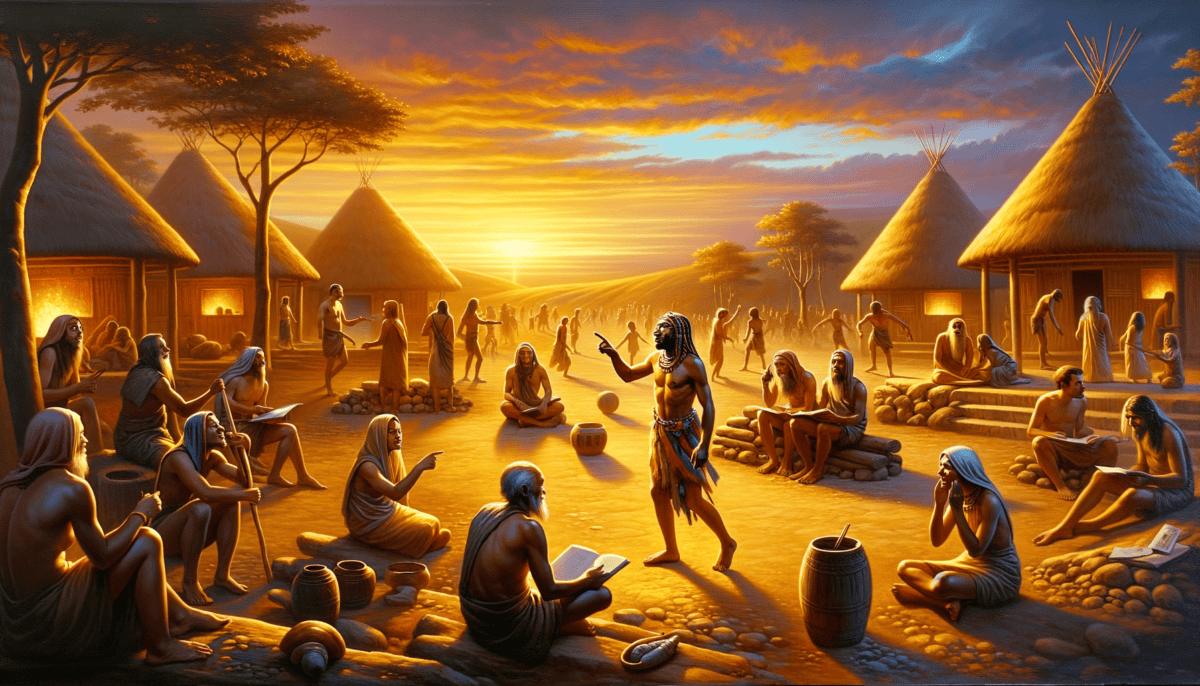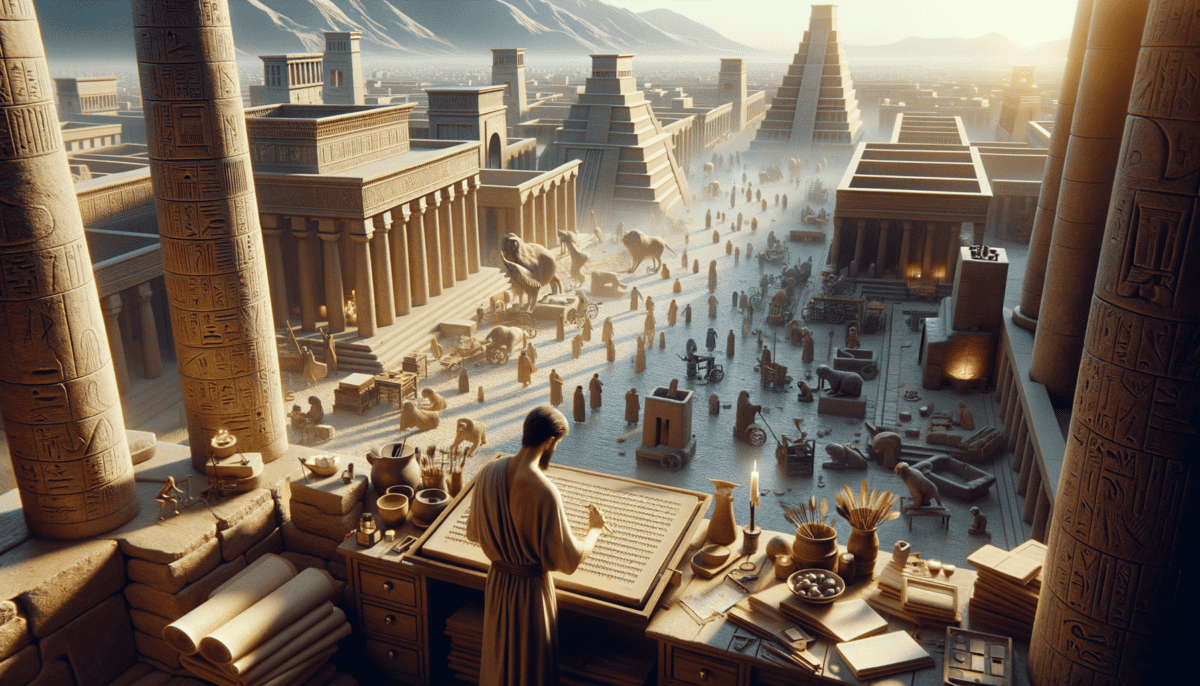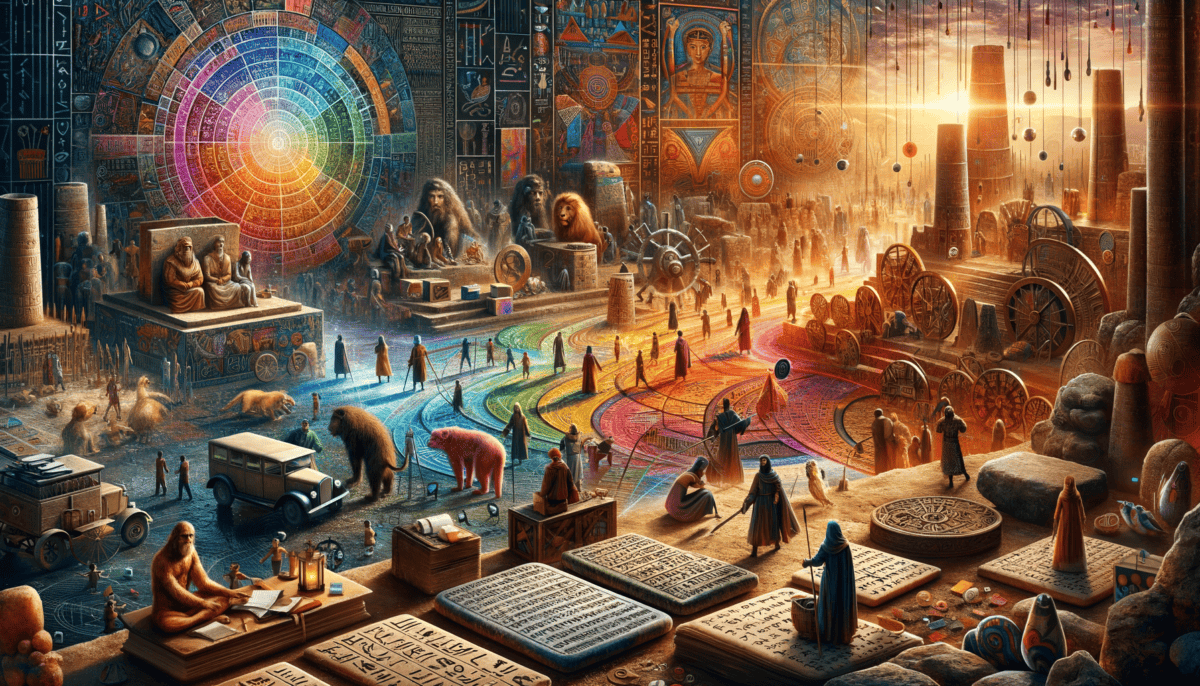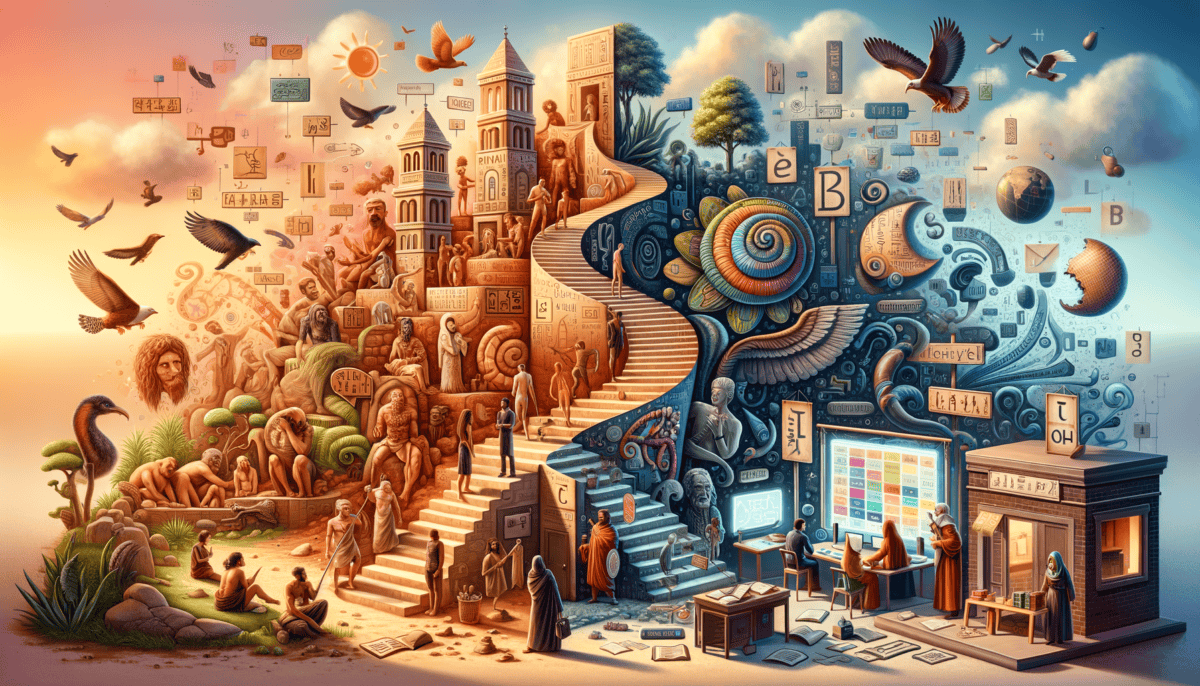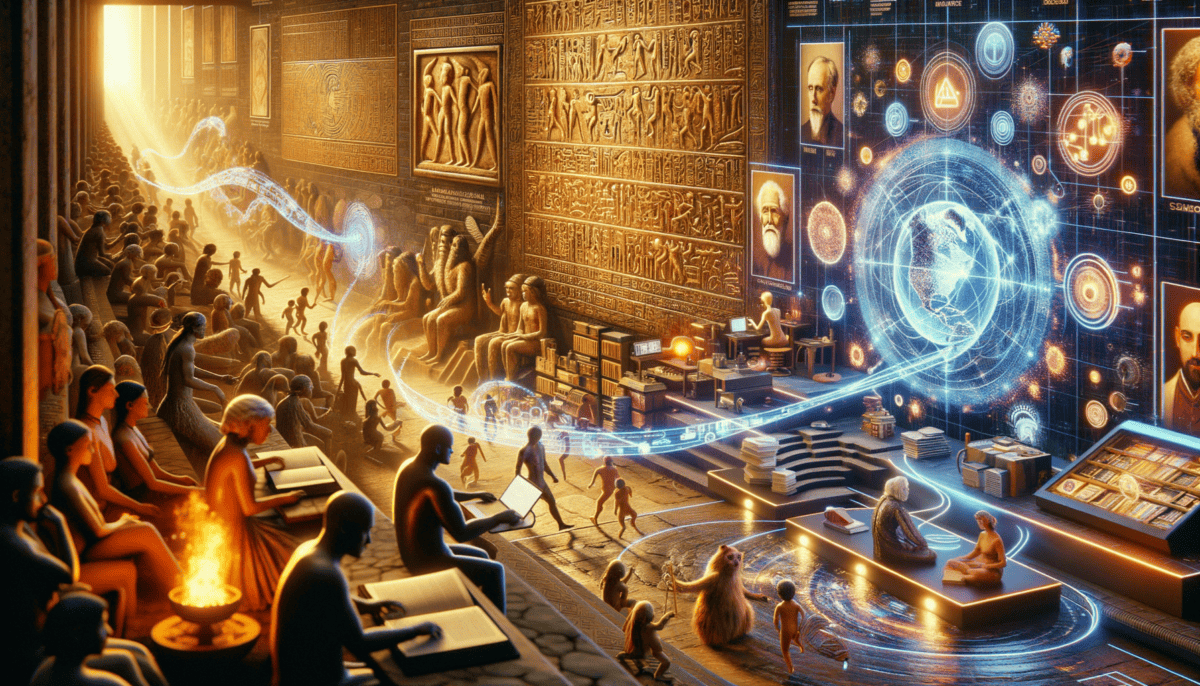Whispers of the First Words
Long, long ago, before anyone wrote books or used phones, people lived in a very different world. Let's meet Kara, a young girl from a time when humans were just learning to talk!
The sun rose over the misty valley as Kara and her family woke up in their cozy cave. Back then, there were no words like “good morning” or “breakfast.” Instead, Kara’s mother would make soft humming sounds to wake everyone up.
The Morning Hunt
Kara watched as her father got ready to hunt. He didn't need words to teach her about tracking animals. He would point to footprints in the dirt and make quiet animal sounds.
"Grrrr!" Her father pressed his finger to his lips, showing Kara how to stay quiet while hunting. She copied him, learning the important signals that kept their family safe.
• Hand signals
• Face expressions
• Body movements
• Animal sounds
• Whistles
Nature’s Language
Kara was really good at understanding the world around her. She knew that when birds suddenly flew away, it meant danger might be near. When clouds got dark and low, rain was coming soon.
One day, while gathering berries with her mother, Kara heard a strange sound. “Ooo-ooo!” She pulled on her mother’s arm and pointed to the sky. Dark clouds were rolling in.
Her mother smiled and patted Kara's head. She made the same "Ooo-ooo" sound back, showing she understood. This was how they learned – by copying sounds and movements that meant something important.
The First Shared Sounds
As the days went by, Kara's family group started using the same sounds over and over:
- A soft "mmmm" meant food was good
- A sharp "ah!" warned of danger
- A gentle "hoo" called the children home
These simple sounds were the tiny seeds that would one day grow into all the languages we speak today!
The Evening Circle
When the sun set, everyone gathered around the fire. The older members of the group would act out stories about great hunts or dangerous animals. They used their whole bodies to tell these tales – dancing, moving their hands, and making sounds.
Kara loved these evening gatherings. Even without words like we have today, she could understand every story. She learned about brave hunters, where to find sweet berries, and which animals to avoid.
As the stars came out, Kara snuggled close to her mother. She made a happy humming sound – one that would someday become the word for "love" in some faraway future.
The fire crackled, and high above, an owl called into the night. Kara knew that tomorrow would bring new sounds, new signals, and new ways to share ideas with her family. These simple beginnings would slowly grow into something amazing – human language!
The Birth of Spoken Words
Many moons after Kara’s time, something amazing started to happen. People began making new sounds with their mouths! ️ Let’s meet Turo, a boy who lived when humans first started turning sounds into real words.
The Sound Maker
Turo sat by the river, watching his sister catch fish. He noticed how she made different sounds for different things. “Sha” meant fish. “Ku” meant water. Every day, they made new sounds for the things they saw.
“Sha! Sha!” Turo called excitedly as his sister caught a big fish. His mother smiled, understanding exactly what he meant.
Learning New Sounds
The whole group started using these special sounds. When they hunted together, they could now say:
- “Ta” = spear
- “Po” = animal
- “Mi” = me/I
- “Nu” = you
- “Ka” = look!
The First Stories
At night, around the fire, Turo’s grandfather would tell stories using these new word-sounds. “Mi-po-ta” meant “I hunt with spear.” The children loved learning these sound combinations.
One special evening, Turo surprised everyone. He put sounds together in a new way: “Nu-mi-ka” (you-me-look). He had made the first sentence!
Words Bring People Together
As seasons passed, more sounds became words. People could now:
✨ Tell others about good hunting spots
✨ Share which berries were safe to eat
✨ Express feelings like happiness and love
✨ Teach children about dangers
✨ Plan activities together
A Growing Word Family
Different groups started making their own special sounds for things. When groups met, they shared their sounds, and soon everyone knew more words than ever before!
Word Magic! People found out they could use the same sound in different ways:
“Ka” could mean:
– Look!
– Something important
– Pay attention
The Big Change
This was a super important time for humans. With these new word-sounds, they could:
Share ideas better
Work together more easily
Remember important things
Make plans for the future
Turo’s Discovery
One morning, Turo woke up early and watched the sunrise. He had learned so many new sounds that he could now tell his mother exactly what he saw: “Sun-big-bright-beautiful.”
His mother hugged him tight, amazed at how their world was changing. With each new word, they could share more of what they thought and felt. Their world was getting bigger and more exciting every day!
As the sun climbed higher, Turo smiled. He knew that tomorrow would bring even more new words, and with them, new ways to share the wonderful things he saw and felt with everyone around him.
Marks on Stone and Clay
The sun peeked over the horizon as Maya watched her father press shapes into wet clay. She lived in a busy city between two big rivers, in a place we now call Mesopotamia.
A Special Day
Maya’s father was a scribe – someone who knew how to make special marks that could tell stories. “Would you like to learn?” he asked, smiling at her curious eyes.
“Yes, please!” Maya bounced with excitement. “I want to make the marks tell stories too!”
The First Lessons
Maya learned that different marks meant different things:
- A star shape = the sky
- A wavy line = water
- A circle with dots = bread
- A simple house shape = home
- A person standing = human
Writing Changes Everything
Maya watched as merchants used clay tablets to keep track of their goods:
How many jars of oil they had
How much grain they traded
How many sheep were in their flocks
How much honey they sold
Stories in Stone
In Egypt, not far from Maya’s home, people carved pictures into stone walls. These pictures told stories about their kings and gods. They called these special pictures ‘hieroglyphs’.
Writing helped people:
– Remember important things
– Share stories with others
– Keep track of trades
– Send messages far away
A Growing System
As time passed, the marks became simpler. Instead of drawing a whole bird to mean “bird,” people made quick marks that were easier to write. These became the first letters!
Maya’s Own Story
One day, Maya made her own clay tablet. She pressed marks to tell about her pet cat:
“My cat is black. She catches mice. She sleeps in the sun. I love her very much.”
Her father beamed with pride. “Now your story will last forever,” he said. “Anyone who knows these marks can read about your cat, even many years from now.”
Writing Spreads
People from other cities came to learn about writing. They took this amazing idea back to their homes. Soon, many different kinds of writing appeared around the world!
Maya smiled as she watched more students come to learn from her father. She knew that writing was changing their world in wonderful ways. Now stories could travel farther than ever before, and memories could last longer than anyone could remember.
As she practiced her marks in the cool evening air, Maya wondered what amazing stories future writers would tell with the marks they learned to make. Each clay tablet was like a window into someone’s thoughts, waiting to be opened and read.
Many Voices, One World
The morning sun warmed Zara’s face as she watched children playing in the schoolyard. They spoke different languages, but their laughter sounded the same.
A Special Class
Ms. Chen clapped her hands. “Today, we’re going to learn about the many languages people speak around the world!”
“How many languages are there?” Zara asked, raising her hand.
“There are over 7,000 languages!” Ms. Chen smiled. “That’s more than all the kids in our school!”
Language Families
Ms. Chen showed the class a big map. She explained how languages are like big families:
Languages that come from the same place often sound similar, just like brothers and sisters look similar!
A World of Words
The class learned how to say “hello” in different languages:
- English: Hello
- Spanish: Hola
- Mandarin: Nǐ hǎo
- Arabic: Marhaba
- Hindi: Namaste
Moving Words
Ms. Chen told stories about how languages traveled around the world. When people moved to new places, they brought their words with them. Sometimes, languages mixed together like paint colors!
The Language Bridge
During lunch, Zara sat with her friends:
“My grandma speaks Arabic,” Zara shared.
“Mine speaks Mandarin!” said Lin.
“And my dad speaks Spanish,” added Miguel.
Even though they spoke different languages at home, the friends could still play and laugh together at school.
Sharing Stories
The class made a special project. Each student brought a story from their family’s language. Some stories were about clever animals, others about brave heroes.
Words That Dance
Ms. Chen showed how some languages use different alphabets:
English uses ABC
Chinese uses characters
✨ Arabic flows like art
Some languages use clicks and whistles
Building Bridges
At the end of the day, Ms. Chen had a special message:
“Every language is like a different way of seeing the world. When we learn about other languages, we make new friends and understand new ideas!”
The Language Fair
The class decided to have a language fair. They made posters showing words from different languages. Parents came and taught songs in their languages. The classroom became a rainbow of sounds!
On her way home, Zara heard the neighborhood children playing. Some spoke English, others Spanish or Mandarin. Their words were different, but their games and smiles were the same.
That night, Zara drew a picture of the world. She filled it with all the words she had learned. Each language was like a different color, making the world more beautiful.
Words That Change and Grow
Zara sat by her computer, watching her grandmother’s face on the screen. They were having a video chat across the ocean!
New Ways to Talk
“When I was young,” Grandma said, “we had to wait weeks for letters to arrive. Now I can see your smile right away!”
“That’s amazing!” Zara giggled, sending her grandmother a heart emoji ❤️.
The Language Dance
Ms. Chen began class with exciting news. “Today, we’re going to see how languages change and grow, just like you do!”
Languages are always changing! New words join old ones, like new friends joining a playground game.
Word Time Machine
The class learned how words change over time:
- Old words get new meanings
- New things need new words
- Different languages share words
- Some words disappear
- New words are born every day
Technology Tales
Ms. Chen showed pictures of old phones and computers. “These didn’t exist long ago. We had to make new words for them!”
“Like selfie!” shouted Miguel.
“And emoji!” added Lin.
“And hashtag!” Zara chimed in.
Language Mixing Bowl
The class played a game called “Language Chef.” They learned how words from different languages mix together:
English borrowed “pizza” from Italian
Japanese borrowed “computer” from English
Arabic gave us “sugar” and “coffee”
Saving Special Words
Ms. Chen told them about languages that need help:
“Some languages are like endangered animals. We need to protect them so they don’t disappear forever.”
Global Word Web
The class learned about big languages that many people speak:
English flies in airplanes ✈️
Mandarin speaks to billions
Spanish dances across continents
Arabic writes beautiful stories
Tomorrow’s Words
Ms. Chen asked the class to imagine future words. They made up funny names for flying cars and robot pets.
Digital Dictionary
Zara showed her grandmother how to use emoji stickers during their video chat. Her grandmother learned quickly:
“Look, Zara! This flower is for you, and this hug is from me!”
Living Languages
That evening, Zara wrote in her diary about how languages are like gardens. Some words grow, some fade away, and new ones bloom. She drew pictures of word-flowers growing all over the world.
Before bed, she practiced saying “goodnight” in all the languages she knew. Each one sounded like a different kind of lullaby.
Tomorrow’s Talk
Zara bounced excitedly in her seat. Today was the future fair at school!
Amazing Machines
The school gym was filled with shiny screens and clever robots. Each one showed new ways people might talk in the future.
“Look!” Zara pointed at a small pin. “It can translate any language right away!”
“Wow!” Miguel tried it on. “It’s like having all the world’s words in your pocket!”
Smart Friends
A friendly robot named BeeBop showed the kids how it could learn any language in seconds.
BeeBop spoke to each student in their family’s language. It even knew sign language!
Global Stories
Ms. Chen gathered everyone around a giant globe. It glowed with thousands of tiny lights.
“Each light shows a different language,” she explained. “Every one is special. Every one tells different stories.”
Brain Games
The kids tried on special headsets that could share thoughts and feelings:
Pictures, colors, and feelings floated between friends like magic butterflies.
Space Chat
A scientist showed them how astronauts might talk to aliens:
- Light signals
- Math patterns
- Music notes
- Picture messages
- Brain waves
Kind Words
Lin tried a kindness translator. It helped make sure words were always friendly and clear.
World Wide Welcome
The fair ended with a special surprise. Students from schools around the world joined them through giant screens. Everyone shared songs and stories in their own languages.
Forever Friends
“No matter how we talk in the future,” Ms. Chen smiled, “the most important thing is being kind and understanding each other.”
That night, Zara dreamed of a world where everyone could talk to anyone. She saw people sharing stories across stars and oceans. She saw robots helping old friends stay close. She saw new words blooming like flowers in a giant garden.
From the first cave paintings to tomorrow’s space signals, people will always find ways to share their hearts and minds.
As she drifted off to sleep, Zara whispered “hello” to the future. She knew that no matter how people talked tomorrow, they would always need three special words:
“I love you”


